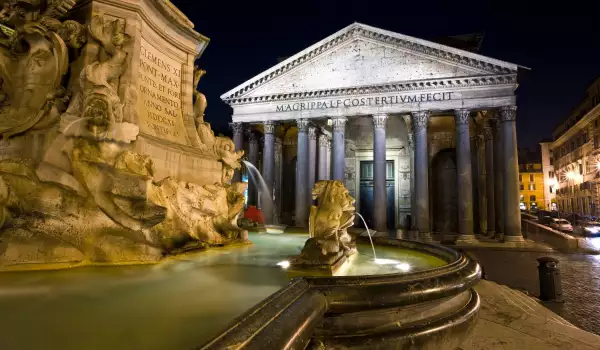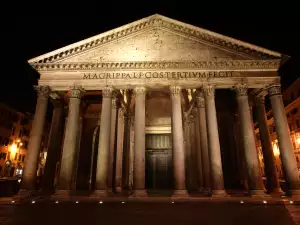Roman Pantheon in Rome

The Roman Pantheon is one of many historical characters of Rome. In fact, the Roman Pantheon is the largest architectural and cultural landmark of the town, as regards to the divine temples.
In literal translation the word pantheon means "all gods". This colossal monument is considered the biggest temple of unreinforced concrete in the world. Millions of tourists from around the world are flocking today in the Roman Pantheon because it is the best preserved building of ancient Rome, to which man can touch today.

It is believed to have been built in 27-25 BC in Rome by Emperor Marcus Agrippa Vipsanius. He was a friend and general of Augustus. It was built as a temple of the nine deities of the seven planets of the official religion in ancient Rome. In its original form the Roman Pantheon was headed by three gods: Jupiter, Mars and Quirinus, whose functions are allocated in accordance with the typical Indo-European tripartite structure: the first is the winner of priestly and royal power, the second - of military force and the third – the defender providing food for all.
Quirinus, an ancient god that probably revered the Italic tribe of Sabina, was later identified with Romulus, the founder of Rome divinized. Later Roman Pantheon became a Christian temple in 7th century. Since its inception throughout its history, the Roman Pantheon serves only as a temple.
Today the Roman Pantheon is home to the graves of the last Italian kings - Victor Emmanuel II, his wife Queen Margaret and his son Umberto I. Their burial chambers are maintained by volunteers of the royalist organization.
Besides the remains of the monarchy, in the Rome pantheon you can be see the remains of the painter Raphael Santsio, Baldasare Peruzzi the architect and musician Arcangelo Corelli.
The apex of the dome of the Pantheon of Rome is hollow, allowing light to enter inside the roof, like the eye. In fact, this part of the temple, represents the eye with the round hole having a diameter of 8. 9 m. It is also called, "eye" ("occula").

A specialist in antique clocks from the University of Otago - Robert Hanna argues that the Roman Pantheon was not only a temple but a giant clock. His hypothesis is based on the fact that during the 6-winter months light from the sun at noon passed a certain time in the dome. In the summer the sun is higher and the beam walks on the walls and floor.
During the two equinoxes - in March and September, sunlight shines a connection between the roof and wall above the north door of the Roman Pantheon. That is the only time of the year in which the sun enters the Roman Pantheon, if its doors are closed. Robert Hanna is clear that this is not accidental. The dome with a hole on top is a typical sundial in Ancient Rome.
The amount of such watches is usually much smaller. The roof of the Roman Pantheon is quite flat when viewed from the outside, but inside it is the perfect hemisphere. At equinox the sun is the celestial equator, considered ideal for an eternal home for the gods. According to Hanna, Romans believed in emphasizing equinoxes, so the Pantheon stands praying to the emperors in the pantheon of Gods kingdom.
Today the Roman Pantheon is still used as a church and there are Masses held regularly for special religious holidays. The height of the structure of this precious monument in Rome is up to 84 meters and its maximum width is about 58 meters.















